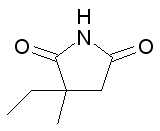Ethosuximide
Ethosuximide is a succinimide anticonvulsant, used mainly in absence seizures. It is sold by Pfizer under the name Zarontin®. more...
Mechanism of Action
There is some controversy over the exact mechanism by which ethosuximide prevents absence seizures. While the "ethosuximide is a T-type calcium channel blocker" gained widespread support following its proposal, attempts to replicate the initial finding were inconsistent.
In March of 1989, Coulter, Huguenard and Prince showed that ethosuximide and dimethadione, both effective anti-absence agents, reduced low-threshold Ca2+ currents in T-type Ca2+ channels in freshly removed thalamic neurons. In June of that same year, they also found the mechanism of this reduction to be voltage-dependent, using acutely neurons of rats and guinea pigs; it was also noted that valproic acid, which is also used in absence seizures, did not do that. The next year, they showed that anticonvulsant succinimides did this and that the proconvulsant ones did not. The first part was supported by Kostyuk et al in 1992, who reported a substantial reduction in current in dorsal root ganglia at concentrations ranging from 7 μM to 1 mM.
That same year, however, Herrington and Lingle found no such effect at concentrations of up to 2.5 mM. The year after, a study conducted on human neocortical cells removed during surgery for intractable epilepsy, the first to use human tissue, found that ethosuximide had no effect on Ca2+ currents at the concentrations typically needed for a therapeutic effect.
In 1998, Slobodan M. Todorovic and Christopher J. Lingle of Washington University reported a 100% block of T-type current in dorsal root ganglia at 23.7 ± 0.5 mM&mdashfar higher than Kostyuk reported. That same year, Leresche et al reported that ethosuximide had no effect on T-type currents, but did decrease noninactivating Na+ current by 60% and the Ca2+-activated K+ currents by 39.1 ± 6.4% in rat and cat thalamocortical cells. It was concluded that the decrease in Na+ current is responsible for the anti-absence properties.
Read more at Wikipedia.org



